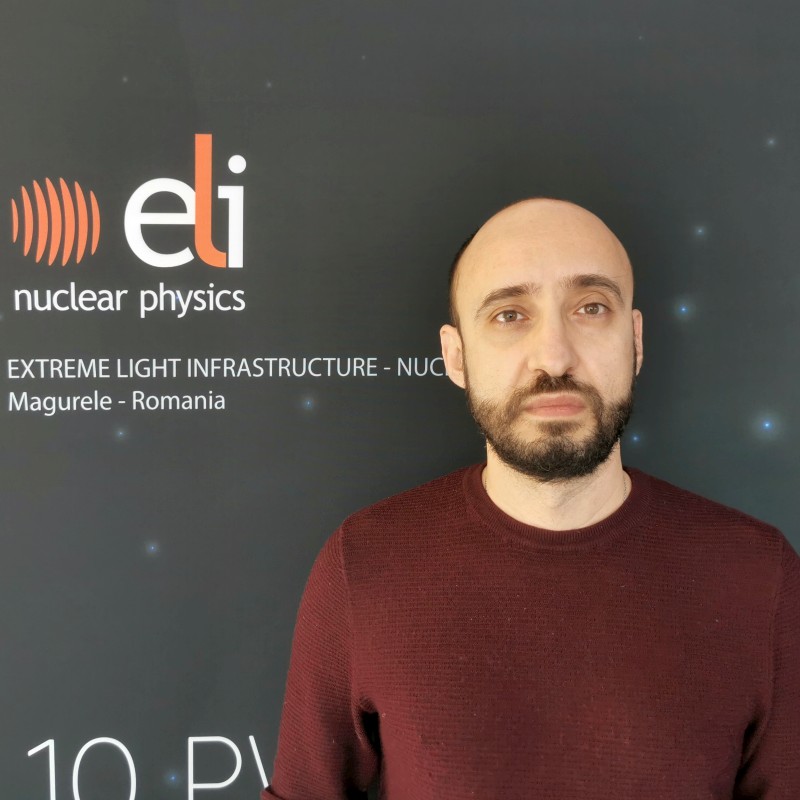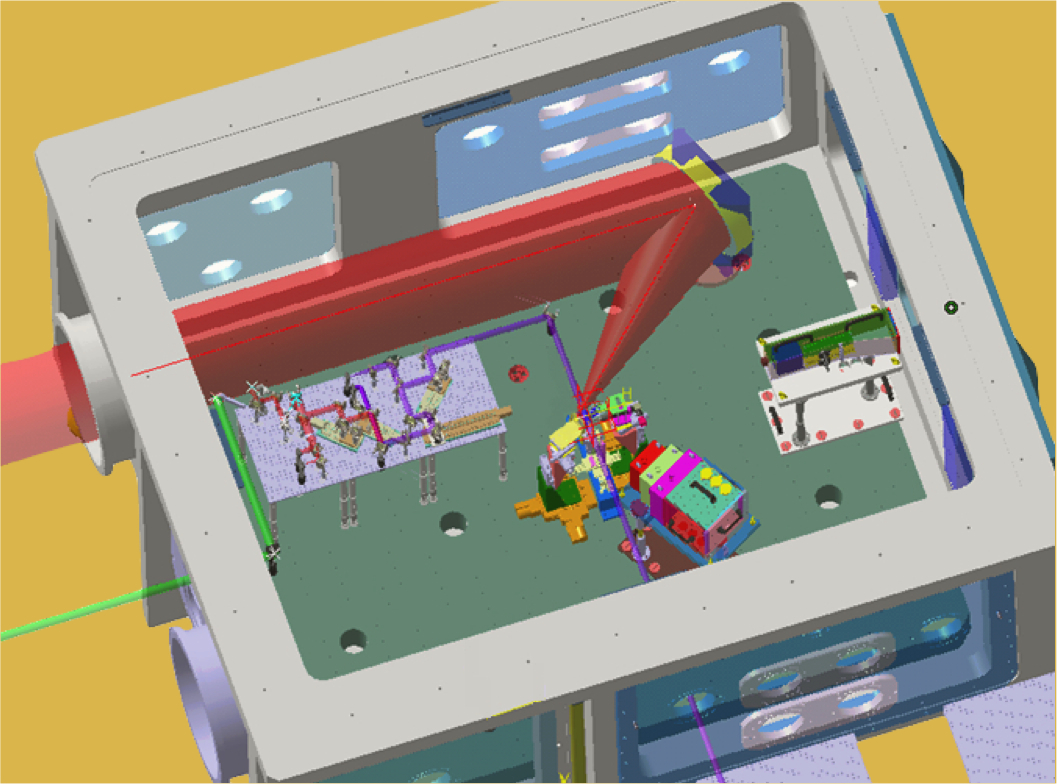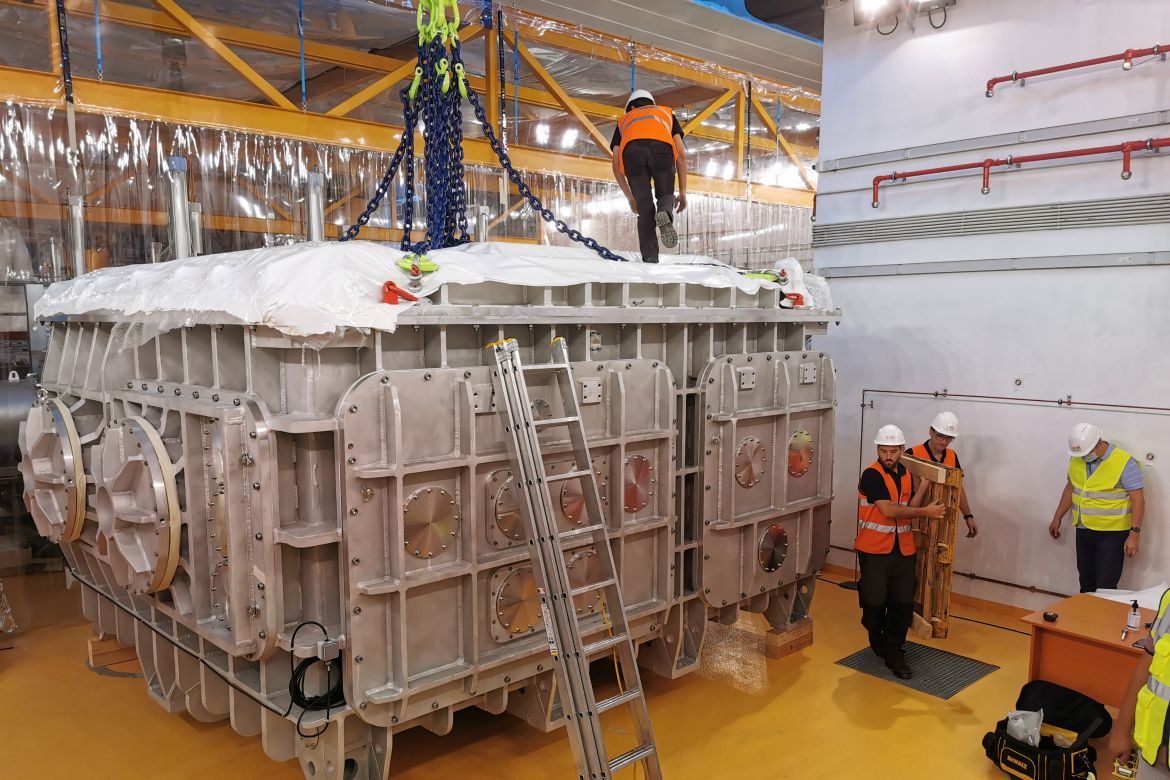The activity of the LDED group is focused on the study of nuclear physics phenomena which are driven by the high power laser interaction with matter. It is envisaged that these studies may lead to a series of new technological applications in interdisciplinary fields. In 2019, our efforts were concentrated towards the implementation of the experimental set-ups in three dedicated target areas: E1, E5, and E6. Each target area will host a large custom-built scale interaction chamber which will be equipped with specialized novel diagnostic tools currently under construction. After the pandemic, we are now successfully transgressing in making our target stations ready for use by external research scientists and plan to become a full User Facility by 2023.
Target chambers at ELI-NP ready for 10 PW shots
The two large target chambers dedicated to carrying out experiments with the 10 PW laser pulses, manufactured by AVS, arrived at ELI-NP at the end of July. For almost a two-week trip started in the North of Spain near Bilbao, they travelled on the sea by cargo ship to the Netherlands and on the road on the back of large trucks, in special conditions, throughout Central Europe all the way to Magurele. Their sizes are impressive: 5 m length x 4 m width x 2 m height. They are both made of aluminium and weigh about 30 tons each. Upon their arrival, they have been unloaded by a 40 tons crane operating above the ELI-NP experimental areas. They have been installed and aligned on their position in the E1 and E6 experimental areas at the beginning of August. Successful vacuum tests have validated a base pressure in the 10-6 torr range. Each chamber is connected to the laser beam transport system through two DN800 ports being able to receive the 10 PW pulses delivered simultaneously by both arms of the ELI-NP high-power laser system. To get a glimpse of all the installation steps click on the snapshot movie edited by the ELI-NP team.
High power lasers are capable of producing high energy charged particles, γ-rays, and neutrons, with peak fluxes orders of magnitude higher than currently achievable with conventional RF accelerator technology. In the E1 experimental area of ELI-NP, these short-duration high fluxes of nuclear particles will be used to study nuclear physics phenomena that are predicted to emerge in plasma conditions, such as:
The production of exotic heavy neutron-rich nuclei by the onset of sequential reactions in plasma (fission-fusion)
The change of the nuclear-stopping power for high intensity, dense bunches of charged particles in which the ion de-acceleration will be dominated by collective phenomena
The change in nuclear cross sections in high power laser induced hot and dense plasmas which simulate astrophysical conditions
Nuclear excitations and de-excitations in plasma conditions leading to changes in the effective lifetimes of isotopes and potentially of other observables
The extremely high laser intensities achievable at ELI-NP will create ultrahigh electric and magnetic fields in the focal spot and will thus allow to exploration of QED in new regimes. Foreseen short- and long-term projects are dedicated to:
The study of quantum radiation reaction created by plasma electrons accelerated to GeV energies
The production of electron-positron pairs in huge abundance and highly energetic gamma-rays emerging from the laser pulse interaction with electrons
High energy gamma-catalyzed production of electron-positron pairs within the laser focus in ultra-high vacuum (long-term goal)
The experimental area E5 is mainly dedicated to material and biological sciences in extreme radiation environments with the main goal of developing industrial, medical and societal applications. The foreseen studies are relevant for the understanding of:
The degradation of materials used in building the next-generation particle accelerators and fusion or fission reactors
- The interaction of biological systems with a multi-component ion and photon radiation pattern spanning over a wide range of energies which will be of relevance for improving biological radioprotection in space missions, and potentially for radiotherapy of cancers
X-rays and gamma-rays will play a central role in the ELI-NP science, operation and societal applications. Intense and spatially coherent X- and gamma-ray secondary sources will be produced in the PW laser interaction with matter. The purpose of the X-ray laboratory is to develop new diagnostic instruments and methods utilizing this radiation, and open new fundamental and applied research directions. The main R&D directions of this unit are: development of X and gamma-ray diagnostics for laser-target interaction, biomedical X-ray imaging applications, and fundamental science and experiments for X- and gamma ray optics.
The main challenge scientists are facing in the measurement of laser-induced nuclear phenomena is that the time scale of the physical events taking place is too fast to be properly measured with modern-day electronics, limited to the picosecond range. As such, to get a glimpse into the ultra-short-lived particle and radiation bursts, one needs to develop an entirely new type of active detector that allows the measurement of the related particle and gamma-ray flashes produced by laser-driven interactions. The Instrumentation Laboratory is meant to allow the development of such state-of-the-art detectors. The detector list contains, among others, a newly designed Thomson Parabola to measure proton energies of more than 200 MeV, and a gamma and electron spectrometer for the 5 MeV to 100 MeV range. A gamma spectrometer dedicated to low-energy gamma radiation of less than 20 MeV is foreseen to be built as well. Besides that, the laboratory will develop and optimize activation stack diagnostics, standard tools in modern-day high-power laser research.
 |
Domenico DORIA | Head of "Laser Driven Experiments Department" | CV Info |
| Name | Position | Info |
|---|---|---|
| Valentin CRĂCIUN | Research Scientist I | |
| Julien FUCHS | Research Scientist I | |
| Klaus Michael SPOHR | Research Scientist I | |
| Cătălin TICOȘ | Research Scientist I | |
| Paolo TOMASSINI | Research Scientist I | |
| Petru GHENUCHE | Research Scientist II (Deputy Head) | |
| Bogdan DIACONESCU | Research Scientist II | |
| Viorel NĂSTASĂ | Research Scientist II | |
| Theodor ASAVEI | Research Scientist III | |
| Marius GUGIU | Research Scientist III | |
| Vojtech HORNY | Research Scientist III | |
| Chieh-Jen YANG | Research Scientist III | |
| Septimiu BĂLĂȘCUȚĂ | Research Scientist | |
| Deepak SANGWAN | Research Scientist | |
| Lucian TUDOR | Research Scientist | |
| Alexandru MĂGUREANU | Physicist | |
| Bogdan COROBEAN | Physicist | |
| Vlad GACIU | Physicist | |
| Mihail CERNĂIANU | Engineer | |
| Dan Gabriel GHIȚĂ | Engineer | |
| Marius JURCĂ | Engineer | |
| Ana-Maria LUPU | Engineer | |
| Mircea PĂTRĂȘCOIU | Engineer | |
| Dragoș POPESCU | Engineer | |
| Matei TĂTARU | Engineer | |
| Sargis TER-AVETISYAN | Engineer | |
| Biliana Dragana DREGHICI | Doctoral Research Assistant | |
| Rares IOVĂNESCU | Doctoral Research Assistant | |
| Oana LAZĂR | Administrative Assistant |



 eli-np.ro
eli-np.ro